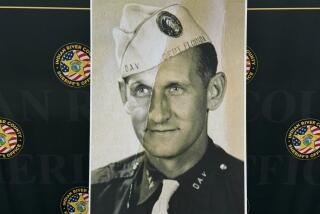Frederic J. Gaynor dies at 74; child model for Daisy air rifle
As a youngster, Frederic J. Gaynor was the rosy-cheeked boy in rolled-up jeans cradling the popular Daisy air rifle. His all-American image in advertisements on the back covers of Boys’ Life magazine, comic books and other publications helped make the rifle a staple on the Christmas lists of countless baby boomers in the 1950s.
Gaynor, who became a Foreign Service officer, died of cancer March 29 at his home in Sarasota, Fla. He was 74.
Frederic John Gaynor was born in Chicago in 1935. When he was 3, a family friend who was a freelance photographer took a picture of him holding a football, titled it “Aspirations” and entered it in a 1938 contest sponsored by Kodak in Britain.
The photo won the first prize of 1,000 pounds and launched the youngster’s modeling career.
Gaynor’s parents registered their son with the Chicago-based Models Bureau, and as he grew into a rosy-cheeked boy with a winning smile, he began to appear in ads for Coca-Cola, Borden’s Milk (with Elsie the cow), 7UP and several hundred other clients.
“He was a cute little boy who did what he was told, so he got a lot of calls,” his wife, Susan Brooks Gaynor, said.
The Daisy ad was created in 1947 for the cover of the company’s annual report.
Gaynor’s all-American image was so well received that Daisy began using it to illustrate its “American Boys Bill of Rights” (including “the right to learn to shoot safely”).
In a 2006 letter to Daisy Outdoor Products, the 127-year-old company now based in Rogers, Ark., Gaynor recalled taking time off from school to do the photo shoot.
“I remember doing three or four different poses,” he wrote. “Incidentally, the wristwatch on my left hand was my father’s watch. My wife wears that watch today. The shirt was a hand-me-down from my older brother. The short-sleeved sweater and jeans were mine. My hair was not really that curly.”
At the end of the shoot, the producer offered young Gaynor a Daisy air rifle, which he desperately wanted, but his mother said no.
Gaynor’s modeling career ended as he moved into adolescence.
He went on to Beloit College in Wisconsin, where he received his undergraduate degree in theater and government in 1957.
After serving in the Army in France, he joined the Foreign Service.
He served with the United States Information Agency in 10 African countries and then in Vietnam with the U.S. and Foreign Commercial Service, an agency of the Commerce Department.
He retired from federal service in 1999 and moved from Virginia to Florida in 2007.
Gaynor’s first marriage, to Annick Lansonneur Gaynor, ended in divorce.
Survivors include his wife of 29 years; a son from his first marriage, Christophe Gaynor of Petersburg, Va.; and a daughter from his second marriage, Antonia Gaynor of London.
“He loved being overseas, particularly in the Third World, because he felt like he could be useful,” Gaynor’s wife recalled. “He was very social, very debonair, spoke impeccable French. He was the essence of joie de vivre.”
He was unaware until a few years ago that the “Daisy boy” had become an American icon as memorable as the rifle itself.
Daisy Outdoor Products still uses the image of the young Gaynor in its logo.
Holley writes for the Washington Post, where this article first appeared.
More to Read
Start your day right
Sign up for Essential California for the L.A. Times biggest news, features and recommendations in your inbox six days a week.
You may occasionally receive promotional content from the Los Angeles Times.






